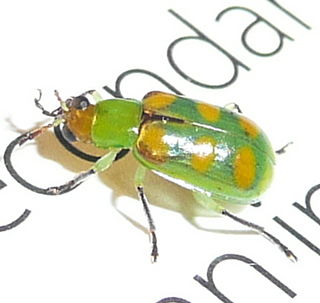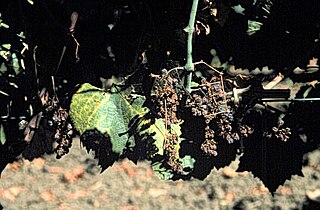An EPPO code, formerly known as a Bayer code, is an encoded identifier that is used by the European and Mediterranean Plant Protection Organization (EPPO), in a system designed to uniquely identify organisms – namely plants, pests and pathogens – that are important to agriculture and crop protection. EPPO codes are a core component of a database of names, both scientific and vernacular. Although originally started by the Bayer Corporation, the official list of codes is now maintained by EPPO.

The European and Mediterranean Plant Protection Organization (EPPO) is an intergovernmental organisation responsible for European cooperation in plant protection in the European and Mediterranean region. Founded on April 18, 1951 and based in Paris, France, EPPO is the Regional Plant Protection Organization (RPPO) for Europe under the International Plant Protection Convention (IPPC).

Xylella fastidiosa is an aerobic, Gram-negative bacterium of the genus Xylella. It is a plant pathogen, that grows in the water transport tissues of plants and is transmitted exclusively by xylem sap-feeding insects such as sharpshooters and spittlebugs. Many plant diseases are due to infections of X. fastidiosa, including bacterial leaf scorch, oleander leaf scorch, coffee leaf scorch (CLS), alfalfa dwarf, phony peach disease, and the economically important Pierce's disease of grapes (PD), olive quick decline syndrome (OQDS), and citrus variegated chlorosis (CVC). While the largest outbreaks of X. fastidiosa–related diseases have occurred in the Americas and Europe, this pathogen has also been found in Taiwan, Israel, and a few other countries worldwide.
Powdery mildew is a fungal disease of barley caused by Blumeria graminis f. sp. hordei. The disease has a worldwide distribution and is most damaging in cool, wet climates. The host range of the form species hordei is restricted to barley and other Hordeum species.

Hyaloperonospora brassicae, in the family Peronosporaceae, is a plant pathogen. It causes downy mildew of species of Brassica, Raphanus, Sinapis and probably other genera within the Brassicaceae. In the past, the cause of downy mildew in any plant in the family Brassicaceae was considered to be a single species Peronospora parasitica. However, this has recently been shown to be a complex of species with narrower host ranges, now classified in the genus Hyaloperonospora, for example Hyaloperonospora parasitica on the weed Capsella bursa-pastoris. From the perspective of plant pathology, Hyaloperonospora brassicae is now the name of the most important pathogen in this complex, attacking the major agricultural and horticultural Brassica species. Other significant Brassicaceous hosts are attacked by different species in the complex, e.g. horseradish by Hyaloperonospora cochleariae, wallflower by Hyaloperonospora cheiranthi.

Pseudomonas savastanoi is a gram-negative plant pathogenic bacterium that infects a variety of plants. It was once considered a pathovar of Pseudomonas syringae, but following DNA-relatedness studies, it was instated as a new species. It is named after Savastano, a worker who proved between 1887 and 1898 that olive knot are caused by bacteria.
Curtobacterium flaccumfaciens is a Gram-positive bacterium that causes disease on a variety of plants. Gram-positive bacteria characteristics include small irregular rods, lateral flagella, the ability to persist in aerobic environments, and cells containing catalase. In the interest of studying pathogenicity in plants, this species is broken down further into pathovars, which help to better describe the pathogen.

Peronospora farinosa is a species name that has been widely applied to downy mildew on leaves of wild and cultivated Amaranthaceae: Amaranthus, Atriplex, Bassia, Beta, Chenopodium, Halimione, Salsola, Spinacia, etc. However, the species name has been taxonomically rejected as the original description contained reference to multiple species and could not unequivocally be attributed to a species of Peronospora. In the past, some of the species on important crop plants have been given names as formae speciales, notably f.sp. betae on sugar beet and f.sp. spinaciae on spinach. However, phylogentic reconstructions have revealed that these "forms" of Peronospora on different genera and their subdivisions, are distinct species, most of which already have previously published scientific names. Such host specialization possibly also exists with respect to the various wild amaranthaceous species given as hosts of P. farinosa.

Phytophthora lateralis is a soil-borne plant pathogen that causes cedar root disease in Lawson cypresses in Northern USA. This pathogen was first noted to cause disease in around 1920 on nursery stock near Seattle. Pacific yew is also vulnerable to P. lateralis but less susceptible than Lawson cypress trees, and tree mortality has only been observed in areas where C. lawsoniana trees were also infected. Asiatic species of Chamaecyparis are generally described as resistant to P. lateralis, although this pathogen is occasionally isolated from Chamaecyparis obtusa in nurseries.

Diabrotica speciosa, also known as the cucurbit beetle and in Spanish as vaquita de San Antonio is an insect pest native to South America. Its larvae feed on the roots of crops. The cucurbit beetle is also known to transmit several viruses such as comoviruses and different mosaic viruses. This is native to South America and is now distributed in Central America and other global areas.

Peronospora destructor is a plant pathogen. It causes downy mildew on leaves of cultivated and wild Allium. Allium cepa is most often affected, while Allium schoenoprasum (chives) and Allium porrum (leek) are only occasionally affected.
Cadang-cadang is a disease caused by Coconut cadang-cadang viroid (CCCVd), a lethal viroid of several palms including coconut, African oil palm, anahaw, and buri. The name cadang-cadang comes from the word gadang-gadang that means dying in Bicol. It was originally reported on San Miguel Island in the Philippines in 1927/1928. "By 1962, all but 100 of 250,000 palms on this island had died from the disease," indicating an epidemic. Every year one million coconut palms are killed by CCCVd and over 30 million coconut palms have been killed since Cadang-cadang was discovered. CCCVd directly affects the production of copra, a raw material for coconut oil and animal feed. Total losses of about 30 million palms and annual yield losses of about 22,000 metric tons of copra have been attributed to Cadang-cadang disease in the Philippines.

"Candidatus Phytoplasma solani" is a phytopathogenic bacterial Phytoplasma species of the 16SrXII group, the causal agent of the black wood of grapevine. The black wood of grapevine disease is classified as part of the grapevine yellows.

Bacterial wilt of carnations is a bacterial disease caused by the plant pathogen Paraburkholderia caryophylli. Previously named Pseudomonas caryophilli, the pathogen is an aerobic gram negative bacteria known for only being capable of entering its host through wounds. Once inside the host, it colonizes the vascular system and roots causing symptoms such as, internal stem cracking, yellowing of the leaves, wilting, and the development of cankers. As a bacterial disease, bacterial wilt of carnations can also be characterized by signs such as bacterial streaming, and bacterial ooze.

Euphorbia davidii, known as David's spurge or toothed spurge, is a species of flowering plant in the spurge family Euphorbiaceae. It is an annual herb growing up to 2 feet tall. Leaves are opposite in arrangement with narrow to broadly elliptic blades.
In December 2018, the United Nations General Assembly adopted a Resolution declaring 2020 as the International Year of Plant Health (IYPH). The purpose of the IYPH was to raise global awareness on how protecting plant health can help end hunger, reduce poverty, protect the environment, and boost economic development.

Pochazia shantungensis is a species of planthopper in the family Ricaniidae. Another scientific name for it is Ricania shantungensis, more commonly known as the brown winged cicada This species is considered an agricultural and forestry pest. It is mainly found along the roadsides in the Zhejiang Province. Also found in orchards in the Shantung province. It has recently been classified as an invasive species within western parts of Korean and Turkey.
Takahashia japonica - the string cottony scale - is an insect pest of ornamental- and economic trees in the Coccidae family. It is a pest of quarantine significance in the EPPO area.











